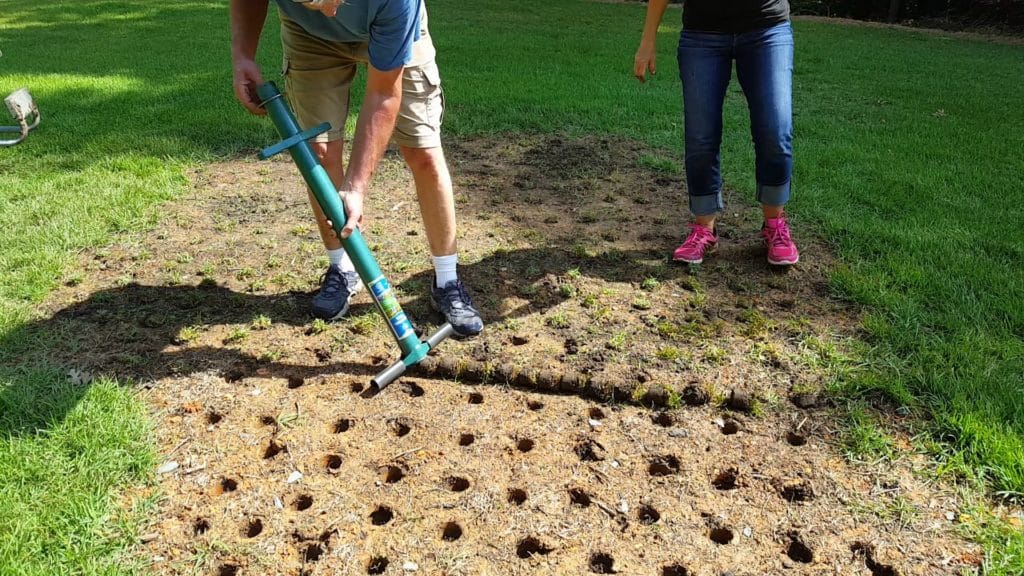Transplant grass plugs from healthy areas of your lawn to bare spots with the ProPlugger
Grasses that can be plugged:
- Creeping grasses that spread above ground through stolons, or below ground through rhizomes.
- Zoysia, Bermuda, Centipede, Kentucky Blue grass, Creeping Red Fescue, Buffalo grass, and Seashore Paspalum
- St. Augustine: We do not recommend plugging in St. Augustine (the plugs tend to fall apart during the process).
Watch the video or follow the directions below
Directions
Step 1: Kill any weeds that have grown in the area that needs repair.
These weeds can grow up and around new plugs before they have a chance to grow.
Chemicals
- Glyphosate
- The old brand name is Round-Up, but there are many formulations.
- I use Hi-Yield Killzall.
- Follow the directions on the label for mixing and spraying.
- Spray it, wait a week, spray it again, wait a week, and then it’s ready.
- The old brand name is Round-Up, but there are many formulations.
Tilling
- This will get rid of your existing grass without the need for chemicals.
Solarizing
- Solarizing involves tilling, watering, and then covering an area with clear plastic during the summer for at least 4 weeks. This is a more involved process but comes with the benefit of killing seeds in the ground, which the other methods don’t do.
Step 2: Water the repair and healthy areas of your lawn the night before plugging.
- Moist soil is much easier to plug than dry soil, particularly if your soil has a heavy clay content.
- Don’t over water.
- If the soil gets too muddy the plugger may clog up, or plugs may have difficulty coming out of the ground.
- Here is a link on how to deal with clogs while using the ProPlugger .
Step 3: Take plugs out of the bare spot 6″ apart.

- Use the 2” depth ring.
- You can use the 4″ depth ring if you are transplanting from established grass and want to keep all 4″ of roots.
- Dump your plugs into a wheelbarrow.
- Dispose of this soil.
- You can keep this soil for Step 7 if it doesn’t have weed seeds in it.
- If you’re having trouble with your plugger clogging follow these instructions to unclog the ProPlugger and prevent future clogs.
Step 4: Take plugs out of your healthy grass.
Step 5: Transport the plugs over to the bare spot.

- Be gentle with the plugs when transporting them.
- Some soils can crumble if you aren’t careful.
Step 6: Plant the grass plugs.

- Sometimes plugs can end up being too short, or too tall for the hole. This is because you may have hit a root or rock while plugging.
- Add some loose soil around to add a bit of height to short plugs or crumble a bit of soil from the bottom of tall plugs.
Step 7: Fill up the holes you plugged in the healthy area.

- Use a commercial soil mix that doesn’t have weed seeds in it.
- If there are only a few holes you can fill them up individually.
- If there are a lot of holes, pour some compost or garden soil on the ground, and use a rake to go back and forth until the holes are filled.
Step 8: Water the new grass plugs.

- Your watering schedule will probably look something like this:
- Weeks 1 – 2: 3 times a day for 20 minutes
- Week 3: 2 times a day for 20 minutes
- Week 4: Once daily.
- Thereafter: Follow the normal watering recommendations for the grass you are plugging.
- This is the schedule I use, but you need to adjust it for how hot your climate is and your soil type.
- These links will help you determine your watering schedule.
- Use a watering timer .
-
- They can be a bit tricky to learn at first, but once you get the hang of it they are invaluable time savers.
- Use sprinklers that are adjustable in both directions.
-
- These sprinkler can be adjusted down to water even very small areas.
Step 10: Water the healthy area you transplanted donor plugs from.
- Usually twice a week for 3 weeks.
- After that just follow the normal watering directions for your grass you are plugging.
Step 11: Wait for grass regrowth.
- The bare spot should be covered in 1 planting season.
- The grass you took plugs from will regrow in about 6 weeks.
Be sure to check out the helpful information on our website, including other uses for the ProPlugger including:








